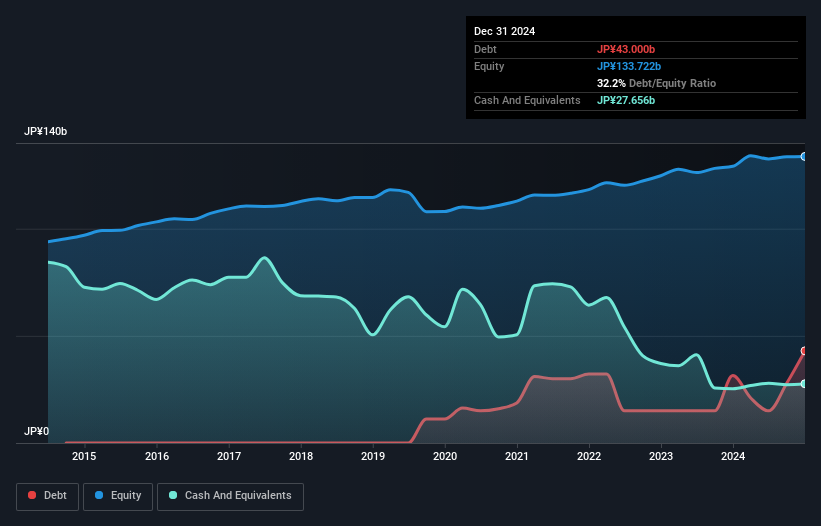
The external fund manager backed by Berkshire Hathaway's Charlie Munger, Li Lu, makes no bones about it when he says 'The biggest investment risk is not the volatility of prices, but whether you will suffer a permanent loss of capital.' It's only natural to consider a company's balance sheet when you examine how risky it is, since debt is often involved when a business collapses. We note that Takamatsu Construction Group Co., Ltd. (TSE:1762) does have debt on its balance sheet. But is this debt a concern to shareholders?
Why Does Debt Bring Risk?
Debt and other liabilities become risky for a business when it cannot easily fulfill those obligations, either with free cash flow or by raising capital at an attractive price. Ultimately, if the company can't fulfill its legal obligations to repay debt, shareholders could walk away with nothing. While that is not too common, we often do see indebted companies permanently diluting shareholders because lenders force them to raise capital at a distressed price. Of course, debt can be an important tool in businesses, particularly capital heavy businesses. When we examine debt levels, we first consider both cash and debt levels, together.
What Is Takamatsu Construction Group's Net Debt?
You can click the graphic below for the historical numbers, but it shows that as of December 2024 Takamatsu Construction Group had JP¥43.0b of debt, an increase on JP¥31.5b, over one year. However, because it has a cash reserve of JP¥27.7b, its net debt is less, at about JP¥15.3b.

How Strong Is Takamatsu Construction Group's Balance Sheet?
According to the last reported balance sheet, Takamatsu Construction Group had liabilities of JP¥104.0b due within 12 months, and liabilities of JP¥30.2b due beyond 12 months. On the other hand, it had cash of JP¥27.7b and JP¥119.8b worth of receivables due within a year. So it actually has JP¥13.2b more liquid assets than total liabilities.
This short term liquidity is a sign that Takamatsu Construction Group could probably pay off its debt with ease, as its balance sheet is far from stretched.
Check out our latest analysis for Takamatsu Construction Group
We measure a company's debt load relative to its earnings power by looking at its net debt divided by its earnings before interest, tax, depreciation, and amortization (EBITDA) and by calculating how easily its earnings before interest and tax (EBIT) cover its interest expense (interest cover). The advantage of this approach is that we take into account both the absolute quantum of debt (with net debt to EBITDA) and the actual interest expenses associated with that debt (with its interest cover ratio).
Takamatsu Construction Group's net debt is only 1.1 times its EBITDA. And its EBIT covers its interest expense a whopping 79.3 times over. So we're pretty relaxed about its super-conservative use of debt. While Takamatsu Construction Group doesn't seem to have gained much on the EBIT line, at least earnings remain stable for now. When analysing debt levels, the balance sheet is the obvious place to start. But it is future earnings, more than anything, that will determine Takamatsu Construction Group's ability to maintain a healthy balance sheet going forward. So if you're focused on the future you can check out this free report showing analyst profit forecasts .
But our final consideration is also important, because a company cannot pay debt with paper profits; it needs cold hard cash. So we always check how much of that EBIT is translated into free cash flow. During the last three years, Takamatsu Construction Group burned a lot of cash. While that may be a result of expenditure for growth, it does make the debt far more risky.
Our View
Takamatsu Construction Group's conversion of EBIT to free cash flow was a real negative on this analysis, although the other factors we considered were considerably better. There's no doubt that its ability to to cover its interest expense with its EBIT is pretty flash. When we consider all the elements mentioned above, it seems to us that Takamatsu Construction Group is managing its debt quite well. But a word of caution: we think debt levels are high enough to justify ongoing monitoring. When analysing debt levels, the balance sheet is the obvious place to start. However, not all investment risk resides within the balance sheet - far from it. Case in point: We've spotted 1 warning sign for Takamatsu Construction Group you should be aware of.
When all is said and done, sometimes its easier to focus on companies that don't even need debt. Readers can access a list of growth stocks with zero net debt 100% free, right now.
Valuation is complex, but we're here to simplify it.
Discover if Takamatsu Construction Group might be undervalued or overvalued with our detailed analysis, featuring fair value estimates, potential risks, dividends, insider trades, and its financial condition.
Access Free AnalysisHave feedback on this article? Concerned about the content? Get in touch with us directly. Alternatively, email editorial-team (at) simplywallst.com.
This article by Simply Wall St is general in nature. We provide commentary based on historical data and analyst forecasts only using an unbiased methodology and our articles are not intended to be financial advice. It does not constitute a recommendation to buy or sell any stock, and does not take account of your objectives, or your financial situation. We aim to bring you long-term focused analysis driven by fundamental data. Note that our analysis may not factor in the latest price-sensitive company announcements or qualitative material. Simply Wall St has no position in any stocks mentioned.
About TSE:1762
Takamatsu Construction Group
Engages in the construction business in Japan.
Proven track record with adequate balance sheet and pays a dividend.
Market Insights
Community Narratives



